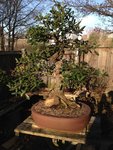Woocash
Omono
Hi all. I’ve seen quite a few bonsai, or rather Yamadori that someone has claimed is this age or that age and I was wondering how on earth can someone even hazard a guess as to the age of a stunted dishevelled old tree with a trunk diameter of say, a twenty year old “healthy” tree? I’ve seen at least a handful of 500 year old claims, but how can that even be possible? I mean, who’s to say what the difference of 300 or 400 years could be without cutting through it? I’m sure there are plausible reasons for the guesses but are there any good reasons as to why?
While I’m at it, how long is a piece of string?
While I’m at it, how long is a piece of string?

